
21+ Best Things To Do In Bonaire: Perfect 1-day Itinerary For Under $50 Per Person (2023)

You may know of Bonaire as a great place to scuba dive and snorkel or to windsurf and kiteboard, but why else should you visit Bonaire, you ask? In this travel guide, I’ll share the 21+ best things to do in Bonaire and how to visit this enchanting island on a budget of less than $50 a day.
Bonaire is the smallest of the three ABCs (Aruba, Bonaire, Curacao), meaning it’s easy to get around and see the highlights in a short amount of time and it’s also a playground for nature lovers. There are countless snorkel and dive sites accessible just off the shore that are teeming with coral, fish, and other sea creatures as well as several animal sanctuaries and national parks. The capital of Kralendjik is a rainbow of colors and golf carts and cyclists abound on this happy island. The coral-covered beaches and cacti are a sight to see. And not to mention, the pink salt flats that are such a stunning contrast to the bright blue Caribbean sea!
Fees For Visiting Bonaire
As of July 1, 2022, Bonaire replaced its former hotel and car rental tax with a mandatory entry tax of $75 for all visitors over the age of 13 ($10 for those under 13). You can pay this tax in advance of your arrival or pay it when you land at Flamingo International Airport. As cruise ship passengers, we were exempt from this tax!


Something else to be aware of is that people arriving in Bonaire by plane will need to pay a $40 fee (per calendar year) in order to visit the Bonaire National Marine Park, Washington Slagbaai National Park, the Mangrove Center, and Klein Bonaire. This includes participating in any water activities, such as snorkeling, scuba diving, windsurfing, and kayaking anywhere on the island.
Passengers arriving by cruise ship are currently exempt from this fee unless they choose to visit Washington Slagbaai National Park, in which case they only need to pay $10. However, starting in 2024, cruise ship passengers will need to pay $10 to enter the Bonaire National Marine Park which includes all the waters surrounding Bonaire and Klein Bonaire, from the high-tide mark to 60 meters (200 feet) of depth. The $10 fee will still include access to Washington Slagbaai National Park and the Mangrove Center as well.

Exemptions to the Bonaire National Marine Park fee include children under 13 years old; residents of Bonaire, Aruba, Curaçao, Saba, Sint Maarten, and Sint Eustatius.
You can pay your entry fee to the Bonaire National Marine Park ahead of your arrival here.

How I Visited Bonaire For Less Than $50
My husband and I arrived in Bonaire by cruise ship and had a fabulous, jam-packed 8 hours of fun. I spent a total of $45.50 for the day – $25.50 for an electric bike (e-bike) rental + $20 for my lunch including tip. My husband ordered more expensive food and a cocktail for lunch so his total for the day was $68.50 – $25.50 for electric bike rental + $43 for lunch including tip.

As a note, we had our breakfast and dinner on board the cruise ship for Good Dimes and to save time when on the island. We were also exempt from the Bonaire National Marine Park fee since we visited in 2023 and chose to not visit the Washington Slagbaai National Park, thus saving an additional $40 per person compared to if we had arrived in Bonaire by plane.
Read on to learn all about how we spent our day and my top recommendations for the 21+ best things to do in Bonaire.
Good Dimes Tip: If you have limited time, prioritize the southern loop, especially if you want to see the salt flats, kiteboarders, windsurfers, obelisks, slave huts, donkeys, mangroves, and/or the Willemstoren lighthouse. Both the southern and northern loops provide access to flamingos and snorkeling sites with incredible fish. Additionally, you can access nearly all of the highlights of the southern loop on this itinerary for free, including the flamingos of Pekelmeer. You can also see flamingos in Washington Slagbaai National Park and at the Mangrove Center. However, in order to visit either of these places, you’ll need to pay the Bonaire Nature Fee ($40 USD per person 13 years of age and older). Additionally, in order to reach Washington Slagbaai National Park, you’ll need to rent a 4 x 4 or join a paid tour. So if you’re on a tight budget, you may opt to skip those areas and follow my other suggestions below.
My husband and I were able to do items 1-18 (except for items 12, 15, and 16) by e-bike from 9 AM – 5 PM. If you choose a faster mode of transportation, have more time, or generally don’t stop often or for long at points of interest, then you’d be able to cover more ground. It all depends on what you’re most interested in seeing and doing during your time in Bonaire.


21+ Best Things To Do In Bonaire:
- Ride around the island on an e-bike, golf cart, scooter, or rental car
We rented e-bikes but I sort of wished we would have known about the golf cart rentals in advance. With a golf cart, you at least have partial sun protection and you can go much faster than on an e-bike, thus having the ability to cover more ground in a limited time. Plus, you don’t have to be concerned about your battery dying and no sore bums! We did get a workout, as the e-bikes are pedal assist, so you still have to pedal in order to keep your inertia going, but it was an extremely hot and sunny day, and it got a bit touch and go as our water supply started to dwindle along with our battery charge. If I were to do it again, I would rent the golf cart for only $9 more.

It may sound a little funny to travel the island by golf cart, but so many people use golf carts to get around, and we saw plenty of tourists traveling the southern route by golf cart. So, have no fear, it’s completely normal and a safe way to get around.
If you decide you want to rent a golf cart, book your golf cart in advance! Supposedly golf cart rentals can book up 4 months in advance when cruises are in port. Book farther in advance just to be safe! And if the golf carts are fully booked, get on the waitlist in hopes of a cancellation.
Two e-bikes from Bike Rental Delivery Bonaire cost us $51. Another couple from our ship was renting standard bikes from the same outfit, however, if you want to stop and see a lot of things and plan to spend time snorkeling, I wouldn’t recommend a standard bike. Not to mention, Bonaire is super windy. Pair that with a hot and sunny day, and you have a recipe for disaster. I drained my e-bike battery from 5 bars at full charge to 1 bar at the time of return – can you imagine a human battery? I wouldn’t want to test it and get stranded. You also have to travel most of the southern loop before reaching any food or drink options, so you could get yourself into some serious trouble if you’re not fully prepared.

Golf cart rentals from Golf Cart Rental Bonaire are $60 for a single-day rental with a full tank of gas, however, like a rental car, you will need to refill it prior to returning it if you want to avoid additional charges. You can add on a cooler for $4 per day, a portable shower for $10 per day, a snorkel set for $4 per day, and CDW Super coverage which includes zero deductible/deposit, full theft insurance, and flat tire service for $15 per day.
Bike Rental Delivery Bonaire also provides scooter rentals that cost 40 euro/day. You’ll need to provide a valid driver’s license (US, Canadian, or European), however, it’s unclear whether or not you need to have a motorcycle endorsement on your license in order to legally operate a scooter. Keep in mind, if you have travel insurance and you get into an accident on a scooter but don’t have a motorcycle endorsement on your license, your travel insurance may not cover you. The roads are quite rough and poorly maintained in sections, so I wouldn’t recommend a scooter if you don’t have prior experience or aren’t a confident driver.


Keep in mind, if you’re planning to go to Washington Slagbaai National Park, you’ll need to either join a tour or rent a 4 x 4 vehicle AND pay the Bonaire Nature Fee ($40 USD per person 13 years of age and older). Bon4Rent claims to be the cheapest SUV rental company on the island and they’ll even price match in addition to giving you a $5 refund if you find a cheaper rate. At $50 per day + fuel, this is actually a great value for the comfort of AC and the ability to travel offroad and at faster speeds. As a note, the road on the southern loop used to be one way and is therefore quite narrow in sections. It merges from the standard two-lane width to one-lane width despite two-way traffic, so you will have to pull partly off the road and drop half of the car off the shoulder when passing cars from the opposite direction.
- Swing through the colorful Courtyard by Marriott Bonaire Dive Resort on your way down the coast

While riding out of town along Julio A. Abraham Boulevard, I spotted a series of colorful buildings and was intrigued. After turning onto Kaya International, we quickly came to find that those colorful buildings were actually the Courtyard by Marriott Bonaire Dive Resort. We rode our bikes along the path of rainbow buildings which ended at an infinity pool overlooking the inlet. Not a bad place to spend a little time.

- Stop at Te Amo Beach or Palu Di Mangel Beach
Most of the beaches in Bonaire are covered in coral and are therefore “rocky”. For a soft, sandy beach, stop off at Te Amo Beach or Palu Di Mangel Beach just after you pass the airport. Te Amo is a fabulous spot for beginner snorkelers or those who are less confident swimmers, as the reef is located along the shoreline, it’s shallow, and it’s home to calm waters. Come here to spot fish, not coral.

- Admire the pink Bonaire salt flats & pyramids
As you continue your journey further south, you’ll quickly begin to encounter the pink salt flats and pyramids that encompass a large portion of the southern part of the island. It’s quite a sight to see the vast expanse of pink salt flats in contrast to the bright blue waters of the Caribbean all in the same panoramic view.

As the water from the salt flats evaporates through a combination of sun and wind, the salinity of the brine increases. The brine is transported from a series of condenser ponds to crystallizer ponds. As the salinity continues to increase and crystallize, certain bacteria and algae containing carotenoid pigments with a pink hue are able to flourish. Thus why some of the salt flats are more vibrant in color than others, depending on their salinity.
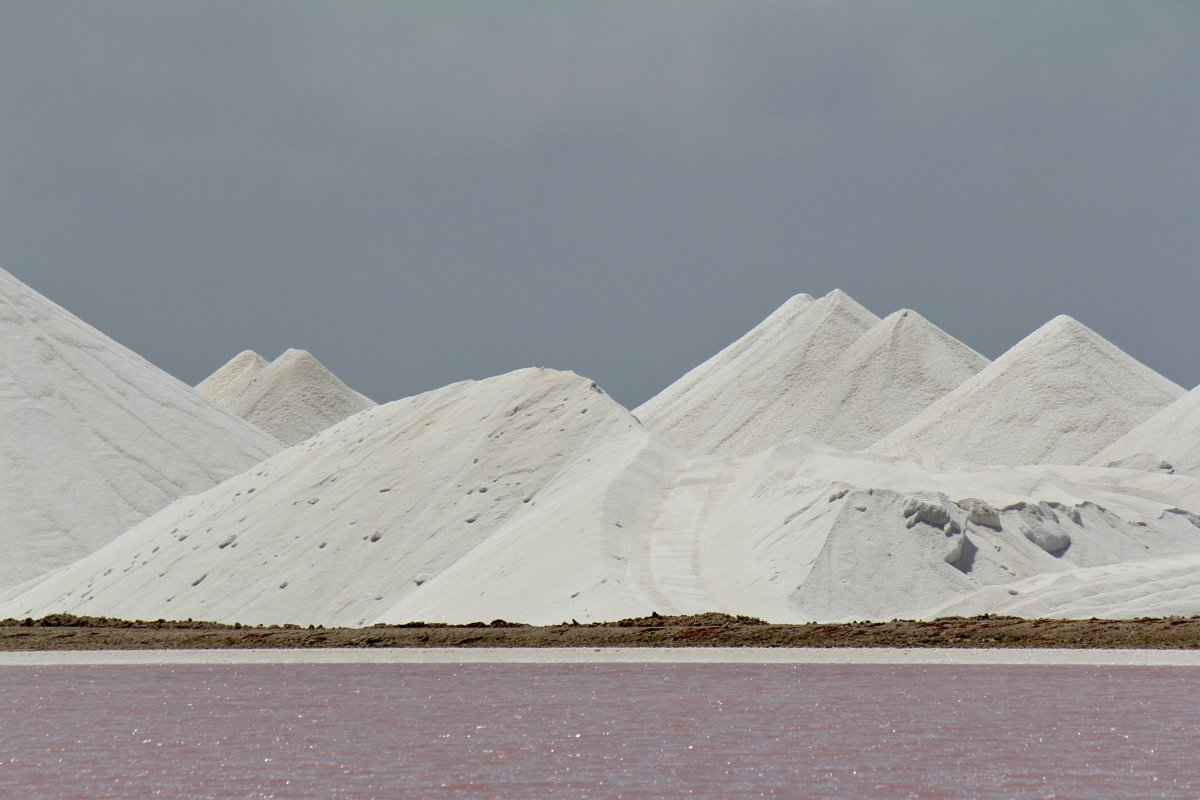
Brine shrimp feast on the bacteria and algae, and flamingos then feast on the brine shrimp, contributing to their pink coat. Shrimp that feast on bacteria and algae with lower levels of carotenoids will actually appear pale pink or gray! The first flamingo we spotted up close was in fact more of a grayish hue which completely perplexed (and disappointed us). However, as we continued on our journey, we spotted another flamingo not far off that thankfully was a brilliant pink.
- Snorkel at the Salt Pier
The Salt Pier attracts a lot of fish because of the coral that’s grown on the pilings. You don’t have to go far from the shore before seeing some incredible fish. We spent at least an hour here immersing ourselves among the fascinating underwater life. If you’re lucky, you may even spot turtles here. A couple we spoke with that was snorkeling at the same time we were said they saw two turtles! The beach is covered in coral and the majority of the entry points are quite rocky, so I’d recommend wearing water shoes or fins.
- Spot the four obelisks along the southwestern coast
The obelisks were constructed in the 1800s as landmarks for sailors to identify the four salt ponds along the southwestern coast in order to identify the exact location to load up their salt cargo for transport. Three of the obelisks are colored for the Dutch flag: red, white, and blue. The fourth obelisk is orange for the Dutch Royal Family, the House of Orange-Nassau.

- Go flamingo spotting at the Pekelmeer sanctuary among the salt flats
We made our first stop at the Pekelmeer sign on the left-hand side of the road and whipped out our binoculars. After a bit of searching, we were finally able to spot some flamingos far off in the distance, but boy did we have to strain our eyes, even with the binoculars! I was initially quite disappointed as I thought that may have been our best vantage point, however, as we continued farther south, my husband spotted a flamingo less than 50 feet from the roadside! We hit the jackpot! Even though the flamingo appeared grayer in color, which was rather shocking and a bit disappointing, I was still totally enthralled as I watched through my DSLR telephoto zoom as the fascinating creature craned its neck at every angle imaginable to prune itself. I never realized how flexible their necks are! We spent quite a bit of time here, entranced by the show, before continuing on our journey.

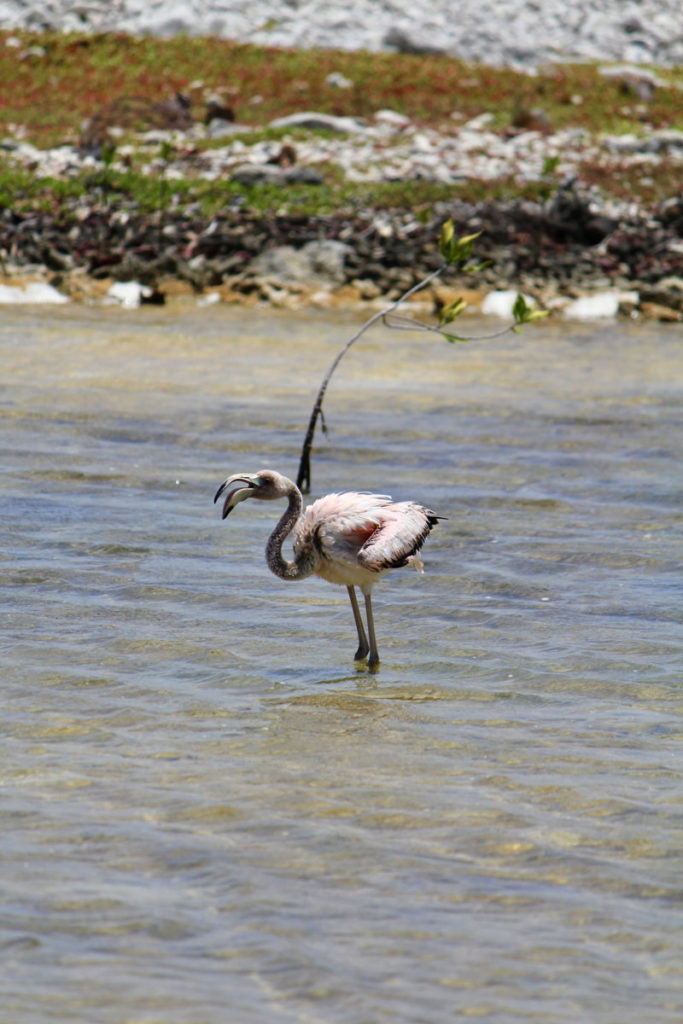
It wasn’t much farther before I spotted another flamingo off to our left, and although it was farther from the road, this one had a brilliant pink plumage. At this point, I was at an all-time high. Any additional sights and surprises along the way would just be the icing on the cake. And let me tell you, that cake ended up having a lot of layers of icing!
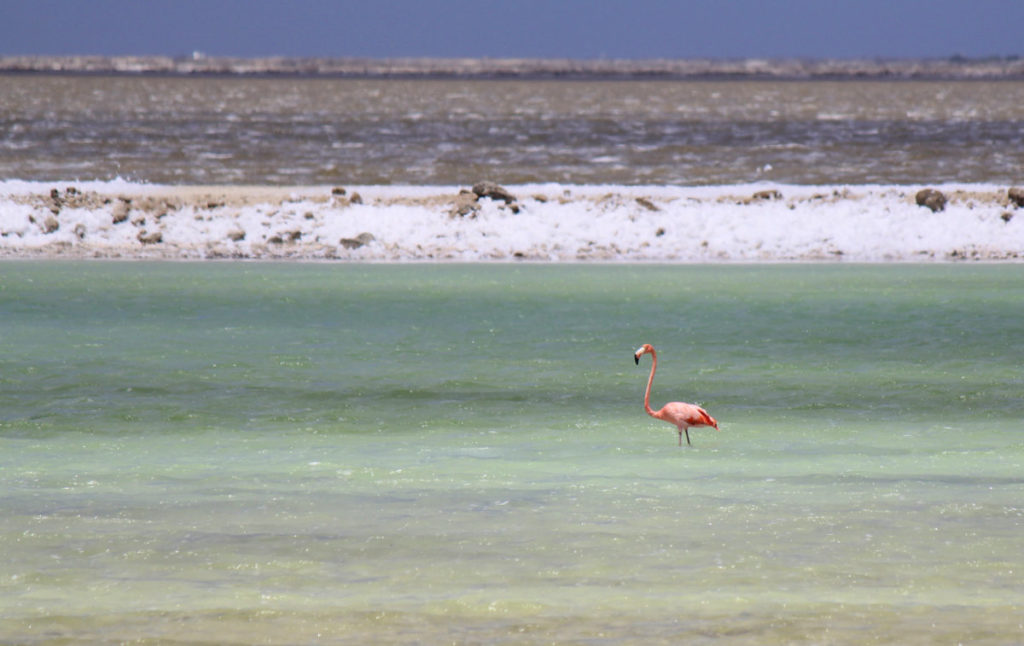
Keep your eyes peeled all along the southern tip of the island on both the right and left side of the road and be prepared to stop at a moment’s notice.

- Learn about the dark past of Bonaire at the Slave huts
There are two areas of slave huts made of coral stone along the southwestern route dating back to 1850. The first area consists of a group of white huts, and the second area is a group of yellow huts, although they are labeled “red slave” on the map. These were inhabited first by Indian slaves and later joined by African slaves brought over to work the salt pans. They also became part penal colony for soldiers. Prior to 1850, the slaves had to either sleep in wooden huts or in the open air. While the coral stone huts sound like an upgrade, a quick glance inside tells you instantly that the living conditions were obviously still quite horrific. The huts are open-air with tiny cutouts for windows and a very narrow door. The space hardly looks big enough for two people, but supposedly up to six people were forced to sleep in one hut. Slavery was abolished in the Dutch Antilles in 1863 and the huts were decommissioned.

- Admire the Kiteboarders at Kiteboarding Bonaire
Long before you reach Kiteboarding Bonaire, you’ll see the dancing kites dotting the sky off the southwestern coast of the island. However, if you want to be in the thick of the action, stop off at Kiteboarding Bonaire to get a close-up glimpse of this famed kiteboarding spot.


- Look out for wild donkeys
It was quite an odd, yet fascinating sight to see donkeys grazing in the wild at the edge of bright sea-green salt flats with flamingos in the distance. We only saw four donkeys, however, we saw evidence of them throughout the southern loop. If you don’t see them along the roadside, there is a donkey sanctuary that you can visit if you’re interested.
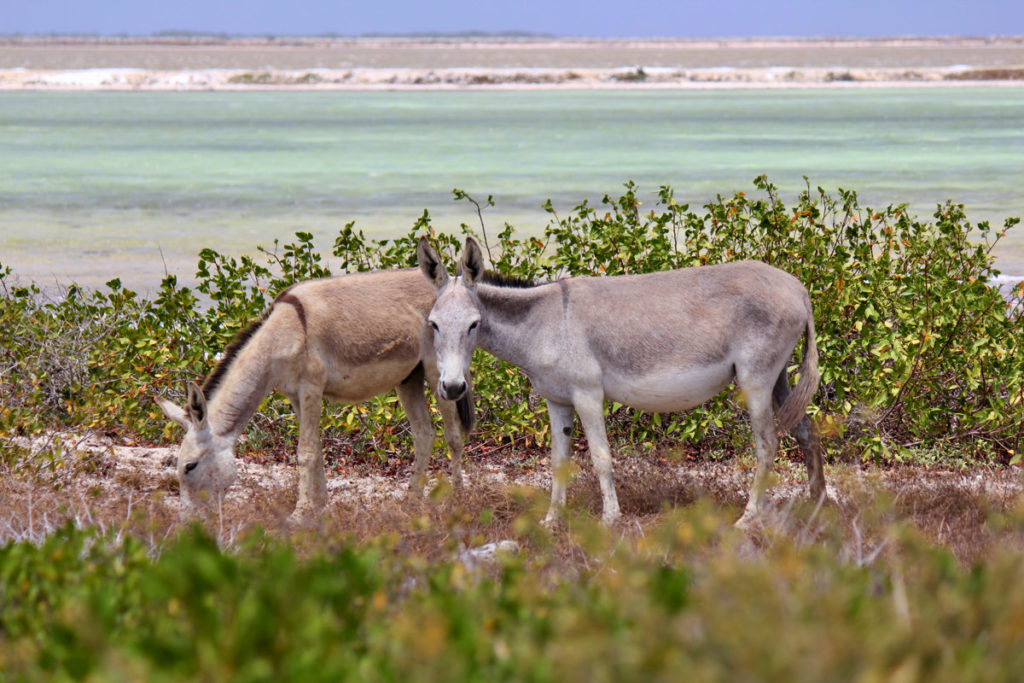
- Stop by the Willemstoren Lighthouse & Keeper’s Cottage Ruins

At the island’s southern tip, you’ll be greeted by the Willemstoren Lighthouse and the ruins of the lighthouse keeper’s cottage. The lighthouse is a unique beige with four maroon vertical stripes. The lighthouse is boarded up, so you can’t enter it, but it’s still a great place for a quick photo op.

- Go to Sorobon Beach (if time allows)
Sadly, we didn’t have time to stop by Sorobon Beach, but it’s reportedly another great snorkeling spot, particularly on a low-wind day. From Sorobon Beach, you can watch the windsurfers on Lac Bay AKA Lac Baii.

- Have lunch or a drink at Foodies
Foodies was such a gem of a place that we stumbled upon out of desperation. We were hot, tired, out of water, hungry, and in serious need of a bathroom break. We had no idea what to expect, but we didn’t care, we saw the fork and knife on Google Maps and we were on our way full speed ahead. As we rode up, we were blown away. It was everything we could have ever dreamed of and more. Delicious local cuisine, a fabulously chic setting with island decor, great music, and a stunning view of the windsurfers on Lac Bay.


- Admire the windsurfers on Lac Bay (AKA Lac Baii)
If you don’t choose to eat or imbibe at Foodies, you should at least stop here and walk out to the point across the road to get a better view of the windsurfers on Lac Bay. As mentioned above, you can also admire Lac Bay from Sorobon Beach. Additionally, you can head to Lac Cai for a different vantage point.
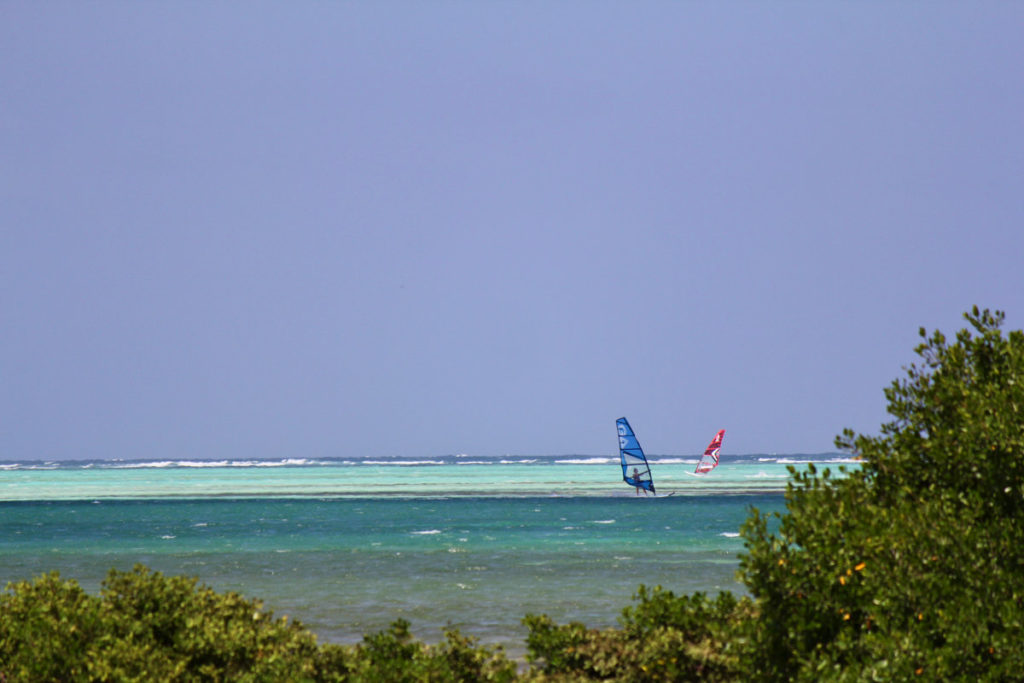
- Stop by the Mangrove Center and rent kayaks or snorkel here (if time and budget allow)
Another 6.9 kilometers past Foodies is the Mangrove Center, although you’ll have to turn off of the main road and head east about halfway there. I’ve heard phenomenal things about the Mangrove Center and the pictures look incredible, so if you have time, I’m sure you won’t be disappointed. There’s also a wild bird rehab foundation on the property, however, you cannot visit the center as the aim of the foundation is to keep all birds “wild”.
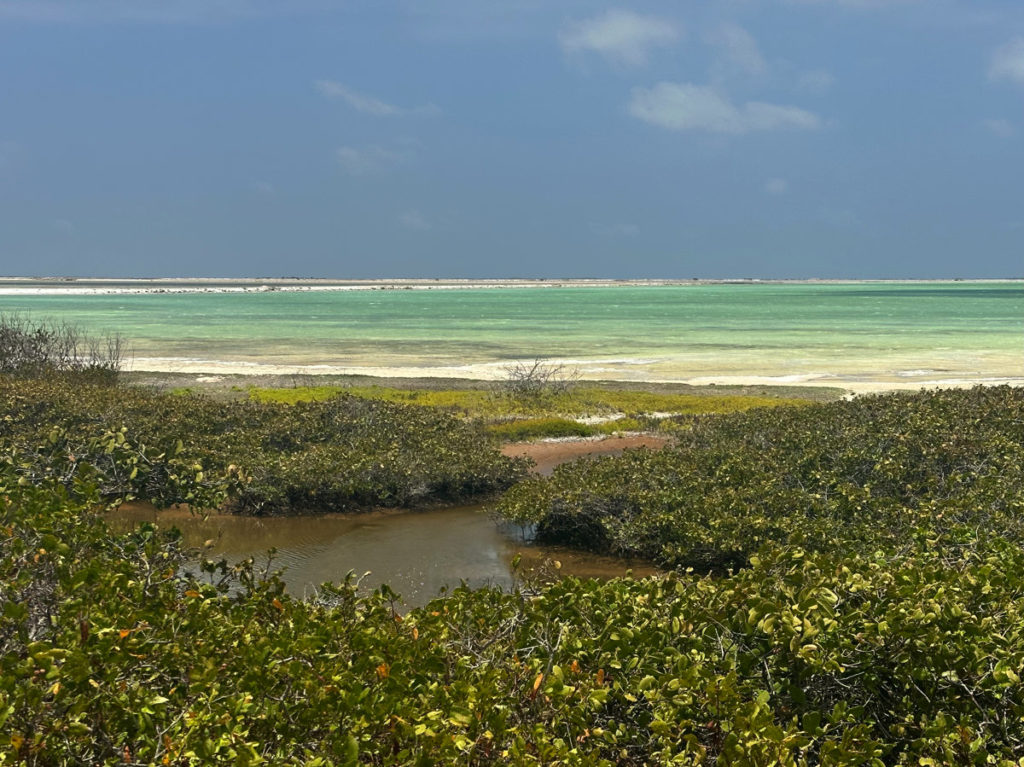
As we were short on time, we didn’t take this detour, especially since we had already seen mangroves, flamingos, and fish along the southwestern side of the island. However, if you have time and your budget allows, you can kayak and snorkel to spot wildlife, including flamingos, queen conch shells, lobster, baby rays, baby seahorses, and lots of fish. The center offers 1 and 2-hour guided kayak tours, however, allow an extra 30 minutes per tour for orientation. The 2-hour kayak tour includes snorkeling. The 1-hour tour costs $30 and the 2-hour tour costs $50. Be sure to bring cash as the Mangrove Center doesn’t accept credit cards.

- Go to Lac Cai beach (if time allows)
The waters of Lac Cai beach are said to be a great spot to search for turtles since there are many seagrass beds here. The road to reach Lac Cai is unpaved, however, it is said that all cars can traverse it. The current can be quite strong due to the location near the mouth of the bay, so it’s not recommended for beginners or those who aren’t confident swimmers. Even for stronger swimmers, the National Park recommends snorkeling these waters with a certified guide that will have a good pulse on the currents.
In order to maximize your chances of seeing sea turtles, enter the water where the boats are moored between the queen conch piles. Swim between the boats to reach the seagrass beds and start searching.
Keep your eye out for the endangered queen conch which can sometimes be spotted in this area. Do not touch the turtles or conch, and maintain a distance of at least 10 feet / 3 meters from sea turtles at all times to protect yourselves and the turtles. The currents impact the sediment levels and ultimately the visibility of this area, thus some days are cloudier than others.
The Lac Bay Bar serves lunch, drinks, and snacks, but be sure to check the hours before you go. A review I read said that it was closed on the weekday that the person went.
- Spot the Flamingo Express (Dutch Caribbean Post Office)
How cute is the Flamingo Express?! If we hadn’t been in Bonaire on a Sunday, I would have loved to have mailed a postcard by the Flamingo Express. The Flamingo Express is located at Plasa Reina Wilhelmina 11 in Kralendijk just adjacent to the Tourism Corporation Bonaire. Note, the Dutch Caribbean Post Office is also closed on Saturdays.

- Take a self-guided walking tour of historical Kralendijk and admire the instagrammable main street (Kaya Grandi) splashed in bright colors and wall art.
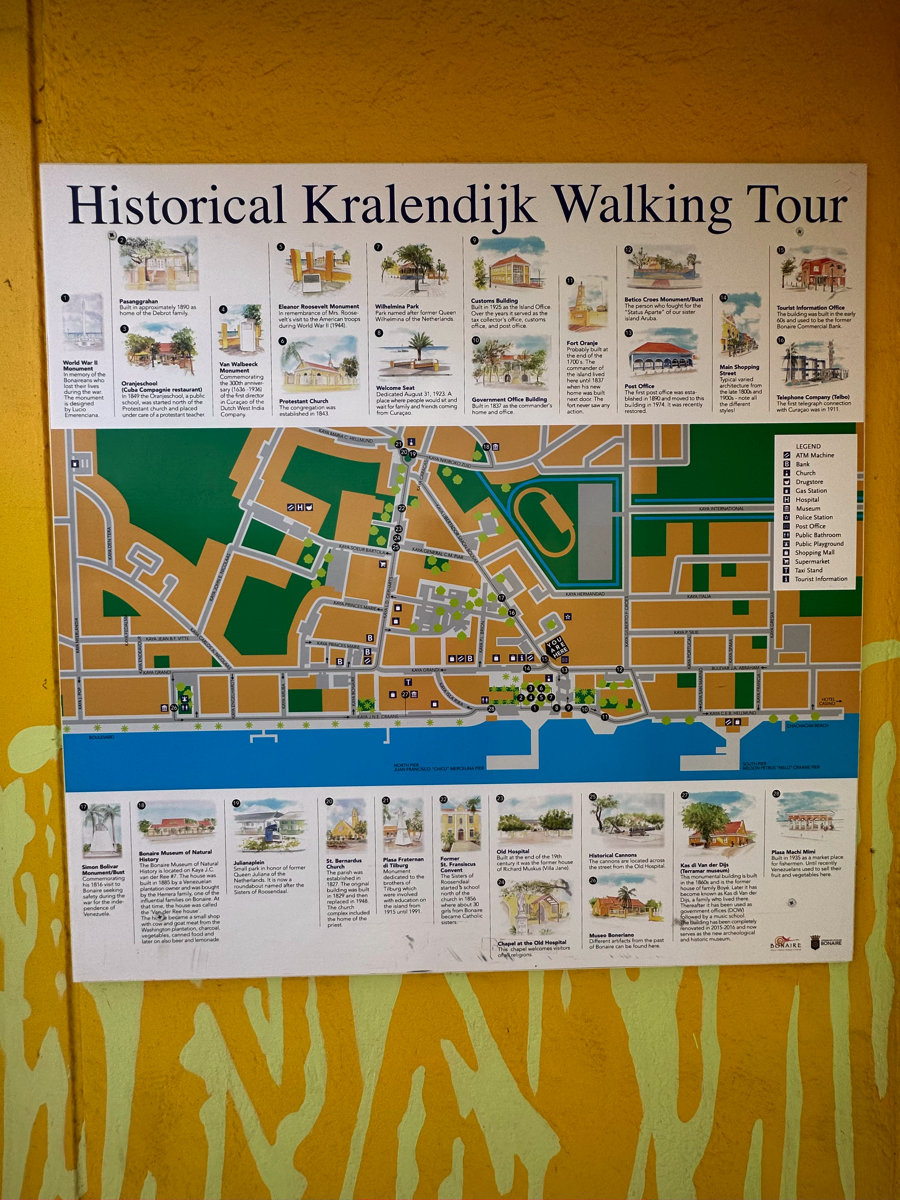
We started our walk along Kaya Grandi at 4:45 PM on a Sunday and unfortunately, almost everything was buttoned up aside from maybe one restaurant and one souvenir shop. While it’s refreshing to see places that still honor the Sabbath, it was sad to not be able to experience the true energy of Bonaire.

It eerily felt like we were in a ghost town! So much so that my husband felt uncomfortable walking down the main street, especially after hearing from a friend that his wife was violently mugged on a Sunday evening in Kralendijk (although that was after dark). I had to remind him multiple times that her encounter was after dark and that we should be fine in broad daylight as long as we were alert and mindful of our surroundings. Needless to say, he was anxious to end our brief tour and get back to the ship. We didn’t see any shady characters and I felt completely safe, but just be aware that apparently Sunday evenings after dark may be dangerous.
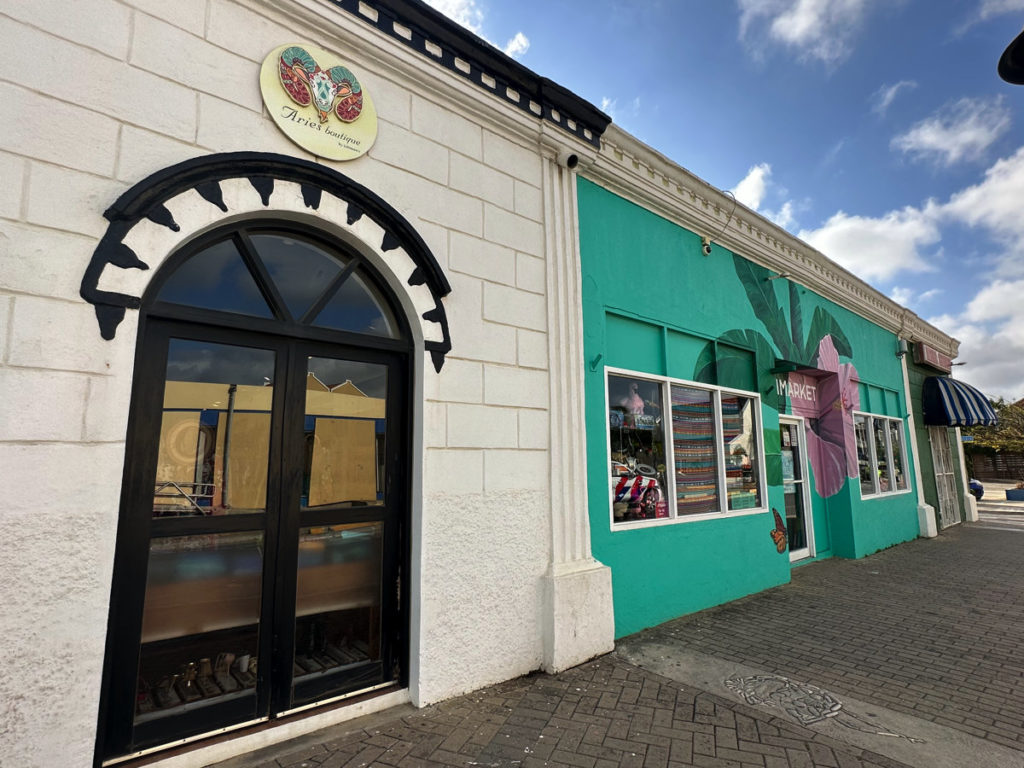

It’d be terrible if I left this post on such a depressing note, so I’ll give you a few more suggestions for things to do in Bonaire if you have additional time.
- Head up north to 1,000 Steps Beach or Karpata for other great snorkel spots.
1,000 Steps Beach is known for the climb down to the beach which is said to feel as though you were walking 1,000 steps when wearing scuba gear despite the journey being much shorter. I’ve read several reviews of people saying this was their favorite beach in Bonaire. Both 1,000 Steps Beach and Karpata are known for having great coral and sea turtle sightings. Karpata is recommended for more advanced swimmers.
- If you didn’t see wild donkeys along the southern loop, you can stop by the Bonaire Donkey Sanctuary.
A visit to the Bonaire Donkey Sanctuary will cost you $9 for adults and $4.50 for children up to 12 years of age.
- Consider renting a 4 x 4 or going on a guided tour of Washington Slagbaai National Park.
Washington Slagbaai National Park boasts 14,000 acres and is home to endemic reptiles and over 200 species of birds including flamingos, parakeets, parrots, and iguanas! The park includes beaches, snorkel and dive spots, and hiking trails. You could easily spend a full day within the park, so you may want to consider it for a longer itinerary on the island in order to get your money’s worth. There are three cabins inside the national park on the Slagbaai lagoon that can be rented overnight for $80 per night excluding the entrance fee and a $100 deposit.
- If you have more than a day, take a water taxi to the uninhabited Klein Bonaire.
Klein Bonaire, meaning small Bonaire, is a small island off the coast of Bonaire. It supposedly boasts the best beach in all of Bonaire and is great for snorkeling.
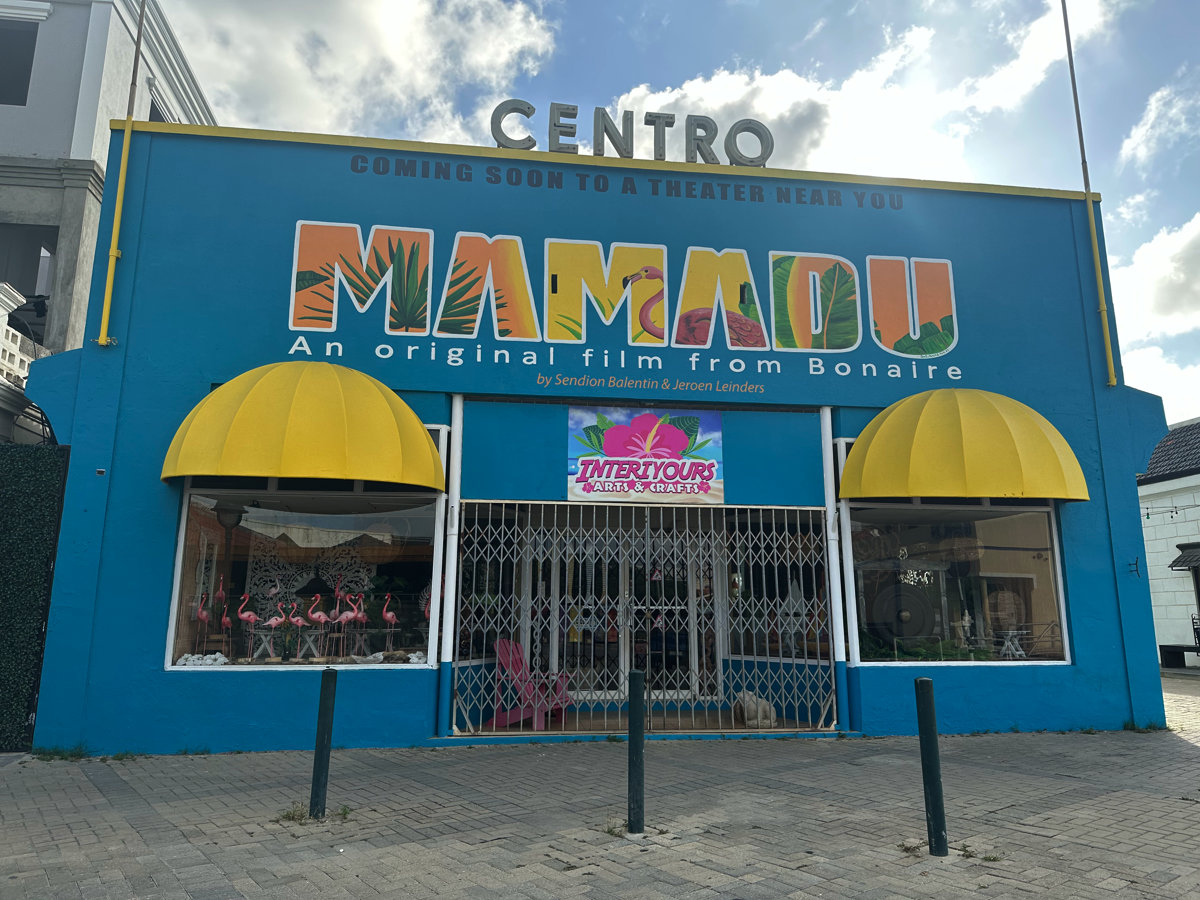
While you certainly could spend much more time than 1 day on Bonaire, my husband and I agreed that we felt as though we saw enough of the island to do it justice and get a really well-rounded experience. Since the island is small, we felt that cruising to Bonaire was a great way to get to the island as it afforded us enough time to see most of the highlights, allowed us to avoid the entry tax, and provided us with both breakfast and dinner so that we only had to spend money on lunch off the ship. If you’re lucky enough to have more time on Bonaire, don’t worry, you could spend weeks there and still not experience all of the snorkel and dive sites off the coast.
I hope this post has either inspired you to visit beautiful Bonaire or gotten you excited for your upcoming trip to this gorgeous place that’s a bit off the beaten path.

If you have other recommendations for your favorite things to do in Bonaire, let the community know in the comments below!
→ If you’re heading to Bonaire on a cruise, check out my post on the 43+ ways to save money on a cruise.






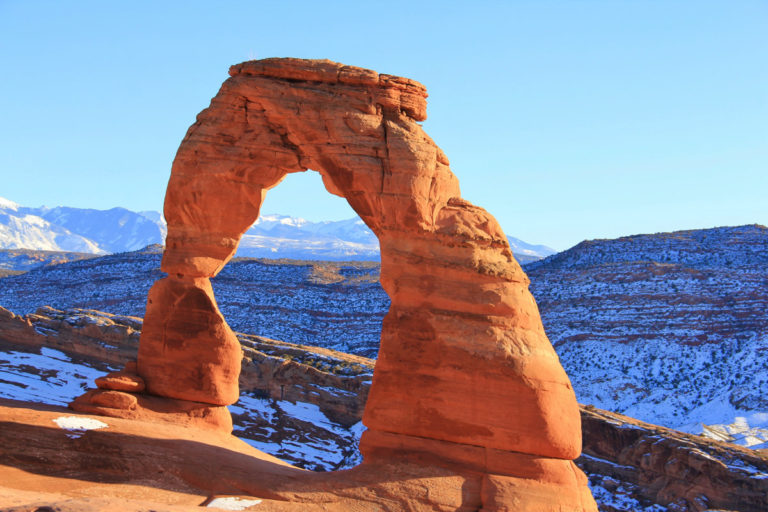

One Comment